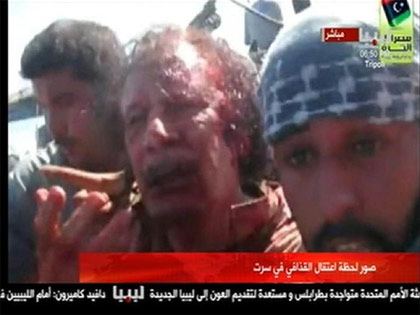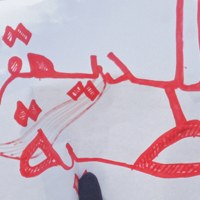![]()
By Crethi Plethi
The UN’s Human Rights Council released an unedited version of a 220-page report on Friday detailing Muammar Gaddafi’s last hours when rebel fighters moved into Sirte, the coastal town Gaddafi fled after he was driven out of Tripoli.
The International Commission of Inquiry on Libya, responsible for the report, was led by Canadian jurist Philippe Kirsch.
They found that in the fighting during the war across Libya in 2011, “both sides committed war crimes, including murder and torture.” Gaddafi’s forces committed “international crimes, specifically crimes against humanity and war crimes, … such as acts of murder, enforced disappearance, and torture … within the context of a widespread or systematic attack against a civilian population,” but — according to the commission — “violations, including war crimes and breaches of international human rights law … such as unlawful killing, arbitrary arrest, torture, enforced disappearance, indiscriminate attacks, and pillage are continuing under the new authorities … at the time of the present report.”
The UN Commission is “concerned by the failure to hold accountable thuwar [anti-Gaddafi forces] committing serious violations. Libyan authorities can break with the Qadhafi legacy by enforcing the law equally, investigating all abuses — irrespective of the perpetrator — and ensuring that amnesty processes comport with Libya’s obligations under international law,” according to the report.
The report also gives a dramatic account of the last hours of the life of Muammar Gaddafi and his son Muatassim.
Muammar Gaddafi’s escape from Sirte and capture by Misrata rebel fighters:
Both Muammar and Mutassim Qadhafi were captured separately on 20 October 2011 outside Sirte by Misrata thuwar. Both, though wounded, were alive on capture, though wounded, and subsequently died whilst in the custody of the thuwar.
On 19 October 2011, Qadhafi’s son Mutassim decided they should leave Sirte because the thuwar had encircled and entered the city, trapping Muammar Qadhafi and his men in District 2. On the morning of 20 October they set off in a heavily armed convoy of approximately 50 vehicles. The convoy consisted of Muammar Qadhafi; his son Mutassim who was already wounded; Defence Minister Abubakr Younis, … and approximately 200 armed men. There were also women and children in the convoy. Some of the armed men evacuated their wounded colleagues from the hospital and these unarmed men were placed in cars with their bandages still on; some still had tubes in their bodies.
The convoy headed east on the main road but ran into a rebel ambush. Numerous cars were badly damaged in the ambush and a number of people were injured. They circled to the sea road and headed west. The convoy split up. At this point a Toyota Corolla in front of Muammar Qadhafi’s green Landcruiser was hit by a NATO airstrike, probably by a Predator drone, and exploded. The explosion set off the airbags in Qadhafi’s car. Muammar Qadhafi and switched cars. The front of the convoy started taking fire from thuwar positions near the power plant and so Muammar Qadhafi, and others took refuge in a house as some of their bodyguards engaged in a fire fight with the rebel positions.
Moments after Muammar Qadhafi entered the house, an airstrike hit the vehicles, setting off secondary explosions. The strike and subsequent explosions left many wounded lying on the ground. At this point the thuwar began shelling the house where Muammar Qadhafi was hiding. Mutassim Qadhafi took approximately 20 fighters and left to look for vehicles. Muammar Qadhafi reportedly wanted to stay and fight but was persuaded to escape. The group belly-crawled to a sand berm. On the way an electrical transformer was struck and electrical wires fell on Qadhafi, striking his head, but he was saved by his blue flak jacket and a Kevlar helmet which was knocked off. The group reached the berm and ran behind it to the road where there were two drainage pipes. The group crawled through the pipes and took up a defensive position on the west side of the road where the pipes terminated.
Muammar Qadhafi crouched outside and between the two pipes. Abubakr Younis was in the right pipe and two fighters took up a position by a berm facing south and the other fighters faced north. The group was sheltered from the road and was unseen by the rebels. … decided the group would make a stand and opened fire on a passing rebel vehicle. There was a fire fight. One of the guards threw a grenade. The grenade hit the top of the cement wall above the pipes and fell in front of Muammar Qadhafi. The guard tried to pick up the grenade but it exploded, killing him, Abubakr Younis, and a fighter next to … was knocked unconscious and Qadhafi was wounded in the blast by grenade shrapnel that hit and shredded his flak jacket. He sat on the floor dazed and in shock, bleeding from a wound in the left temple.
At that point, one of the party fashioned a white flag from his turban and waved in surrender to the thuwar from the 501st Brigade. The thuwar laid the men on their faces and bound their wrists. Muammar Qadhafi was immediately surrounded by thuwar and beaten. Muammar Qadhafi was heard to ask, “What is going on?” The survivors were placed into vehicles and taken away.
This is where the eyewitness evidence received by the Commission ends. Videos of the scene show Muammar Qadhafi being roughly handled by the thuwar, many screaming “We are Misrata” to identify where they are from. He is apparently stabbed with a bayonet in the buttocks. He is placed on the hood of a vehicle, bloody but alive, before being placed in an ambulance. He clearly has one head wound from the grenade shrapnel, but is otherwise not wounded. This is the last time Muammar Qadhafi is seen alive.
A televised interview of one of those who accompanied Muammar Qadhafi in the ambulance gave an account of what happened next. The young man, who states he is from Benghazi but was travelling with men from the Misrata thuwar when the Qadhafi convoy was attacked, claims he was the one that found Muammar Qadhafi and got into the back of the ambulance with him and two men from the Misrata thuwar. The ambulance started to drive to Misrata. The young man claims there was an argument between himself and the men from Misrata on what to do with Muammar Qadhafi, with him wanting to bring Qadhafi back to Bengazi. He claims he shot Qadhafi in the head and abdomen.
The Commission is unable to verify his claims. Video shows he was in the ambulance when Muammar Qadhafi was placed in it. What is clear is that Qadhafi was alive when he was taken into custody and placed in an ambulance in Sirte by members of the Misrata thuwar and was seemingly dead when the ambulance arrived in Misrata.
The Commission visited the site of Muammar Qadhafi’s capture. The details of the site were consistent with the testimony provided by all interviewees. Numerous burned vehicle frames remained at the site as remnants of the NATO airstrike. The area remained scorched and unexploded ammunition lay scattered about the area. There were also numerous fragments of ammunition that had exploded during the NATO airstrike. All of this corroborated testimony that the vehicles had been leaden with weapons and ammunition.
The layout of the area was identical to the testimony, down to the electrical transformer with broken electrical lines draping down that reportedly struck Muammar Qadhafi. Photos provided to the Commission showing the area shortly after the attack with the dead bodies of numerous fighters. Some of them were bandaged and had medical tubing coming from their corpses, as described by witnesses.
According to news reports, the official autopsy states Qadhafi was killed by a gunshot to the head. The Commission was not provided access to the autopsy report despite numerous requests to the NTC. Photos of Muammar Qadhafi’s body were provided to the Commission by members of the medical committee of Misrata who participated in the external examination of Qadhafi’s body. The photos were reviewed by the Commission’s forensic pathologist. He was unable to come to a definitive conclusion of the cause of death. His analysis found one possible cause of death was an injury that appeared to be consistent with a small calibre gunshot wound to the head. There were no powder burns, no muzzle tattooing, or any other sign of a gun muzzle. This indicates the shot, if it was a shot, was fired at a distance of at least 50cm. The photos do not show a clear exit wound, though there were a number of head wounds. The Commission remains equally open to the possibility that the wound to the temple might also be shrapnel from the grenade. Analysis of the photos of the abdominal wounds by the Commission’s forensic pathologist determined they were penetrating wounds in the epigastric area, the nature of which was difficult to determine from photographs. Interviews with journalists who saw the body indicate Qadhafi was shot once in the head and twice in the abdomen.
It was not possible to conclusively determine the cause of death from the photographs provided. While the Commission has eyewitness testimony of those with Muammar Qadhafi at the time of capture, it has not been able to obtain a first-hand account of the circumstances of his death and has received inconsistent accounts from secondary sources. Consequently, the Commission has been unable to confirm the death of Muammar Qadhafi as an unlawful killing and considers that further investigation is required.
The death of Muatassim Gaddafi:
In relation to the death of Mutassim Qadhafi, the Commission has reviewed video footage showing him alive and in the custody of thuwar post-capture but has been unable to obtain any account of the circumstances of his death. Examination of photographs of the body of Mutassim Qadhafi proved inconclusive. Consequently, the Commission has been unable to confirm the death of Mutassim Qadhafi as an unlawful killing and considers that further investigation is required.
The bodies of Muammar and Mutassim Qadhafi were placed on public display in a meat locker in Misrata for three days. He, his son Mutassim, and Abu Bakr Younis were reportedly buried at dawn on 25 October 2011, five days after their deaths. In respect of the public display of the bodies of both Muammar and Mutassim Qadhafi, the Commission found there has been be a breach of international customary law.
You can donwload the 220-page report of the International Commission of Inquiry on Libya here.



 RSS
RSS












Latest Comments
Hello Mike, Thank you for your positive feedback to the article. I felt there wasn’t too much critical analysis of ...
Thanks for this considered and well constructed article. A follow up article on the manner in which the editorial contro...
THE CLUELESSNESS OF CLAIMING THAT OBAMA'S MIDDLE EAST POLICIES WERE A FAILURE CANNOT BE FURTHER FROM THE TRUTH, WHAT THE...
As long as Obama is the president of the usa do not trust the us government......
Thank you for an good read....